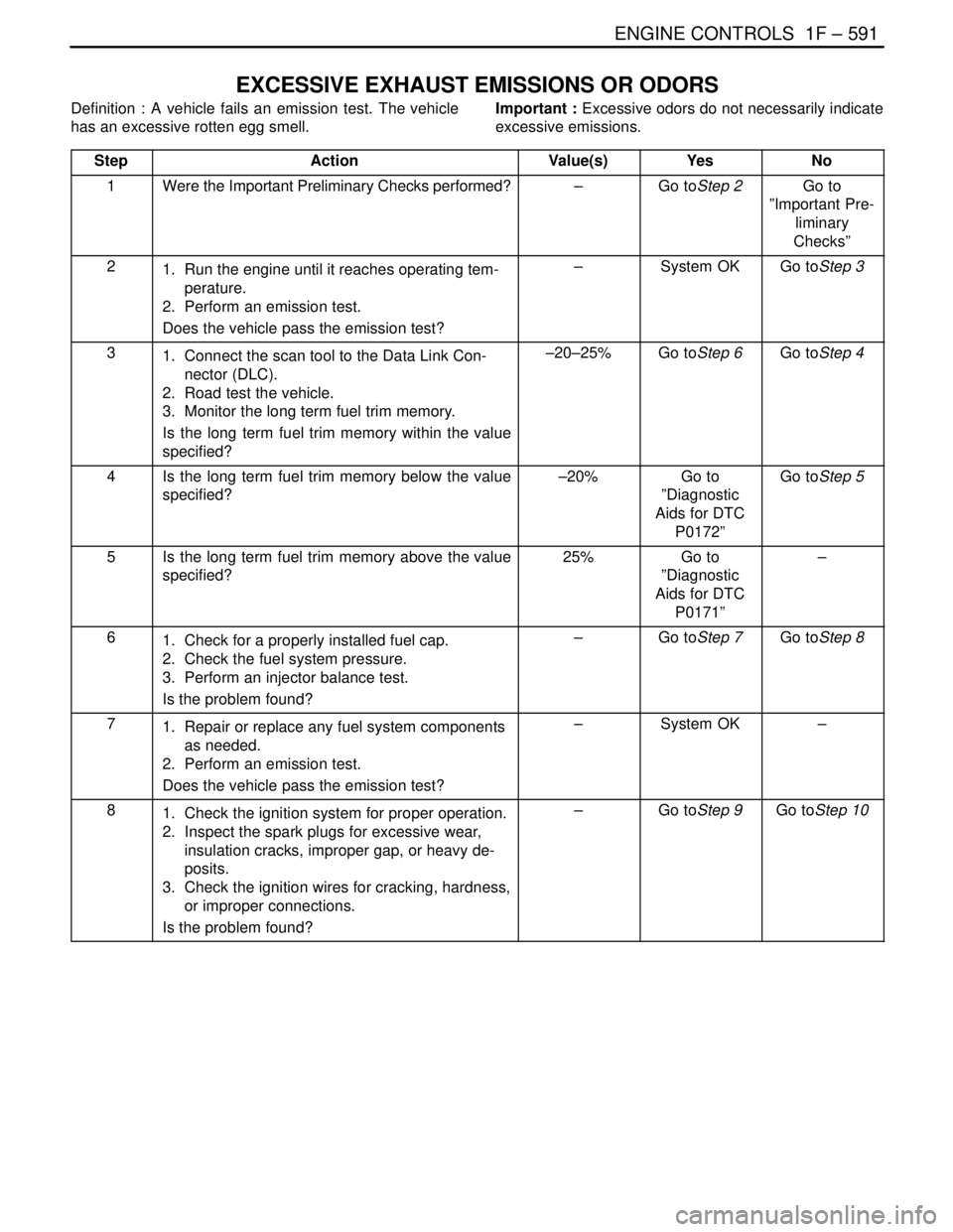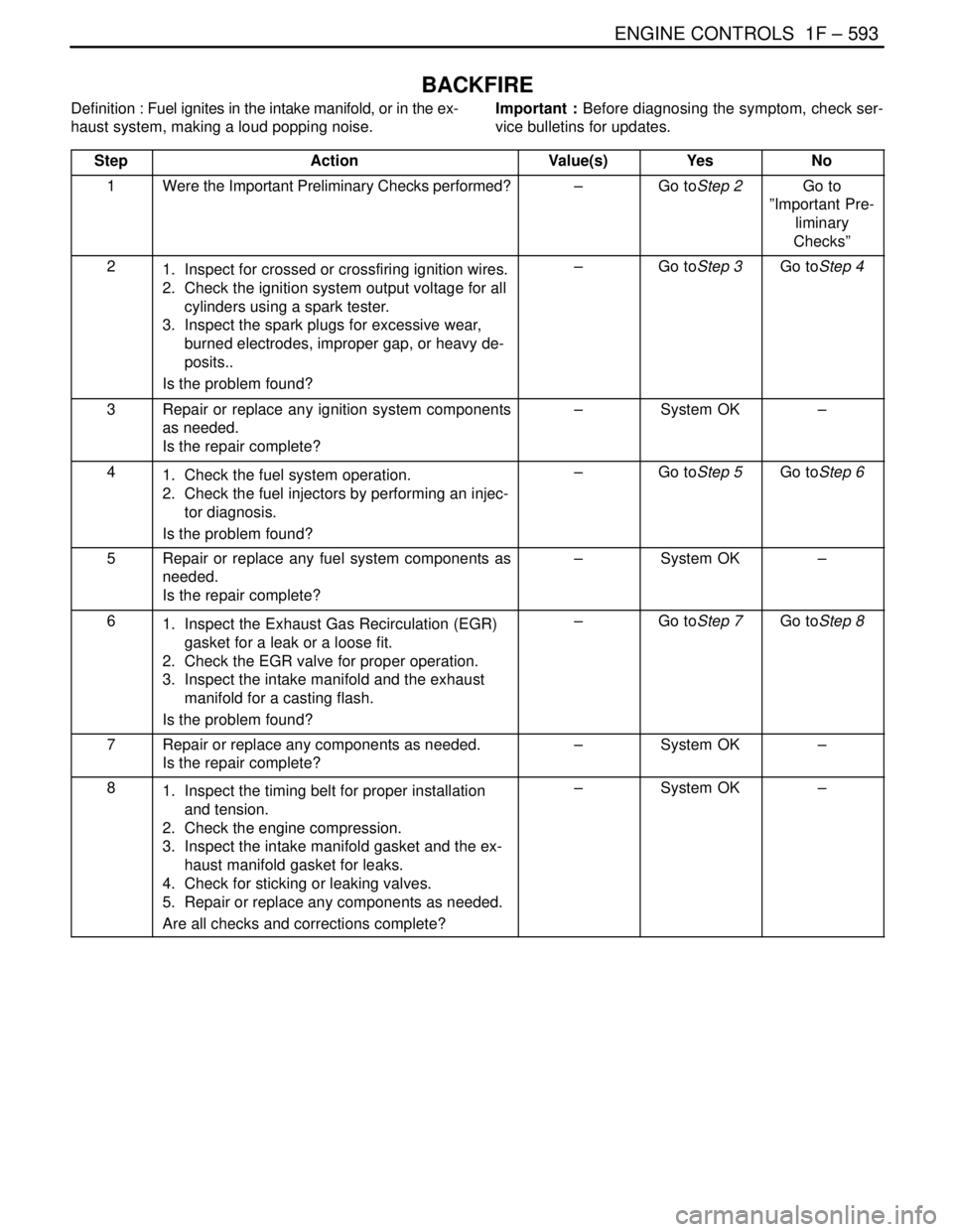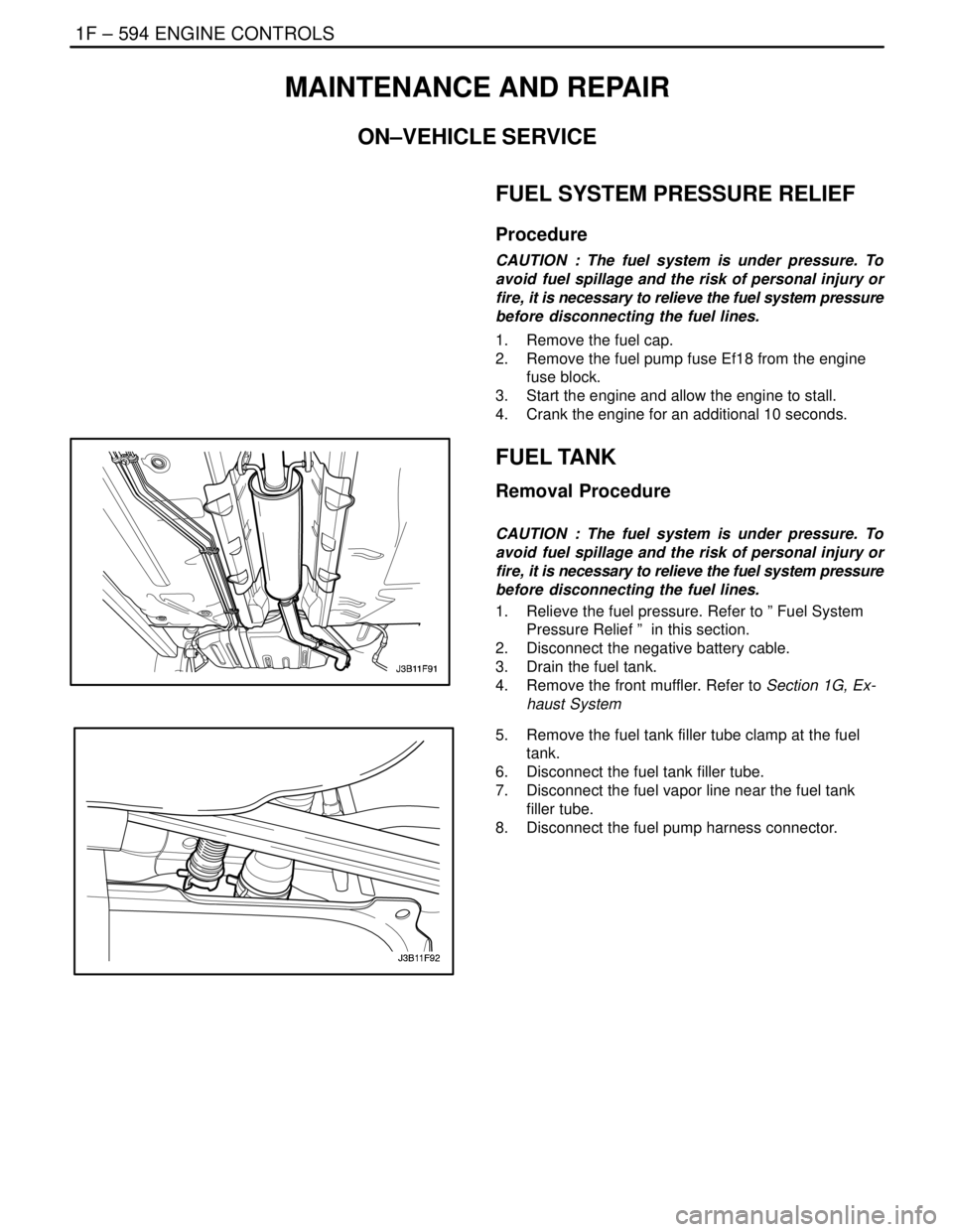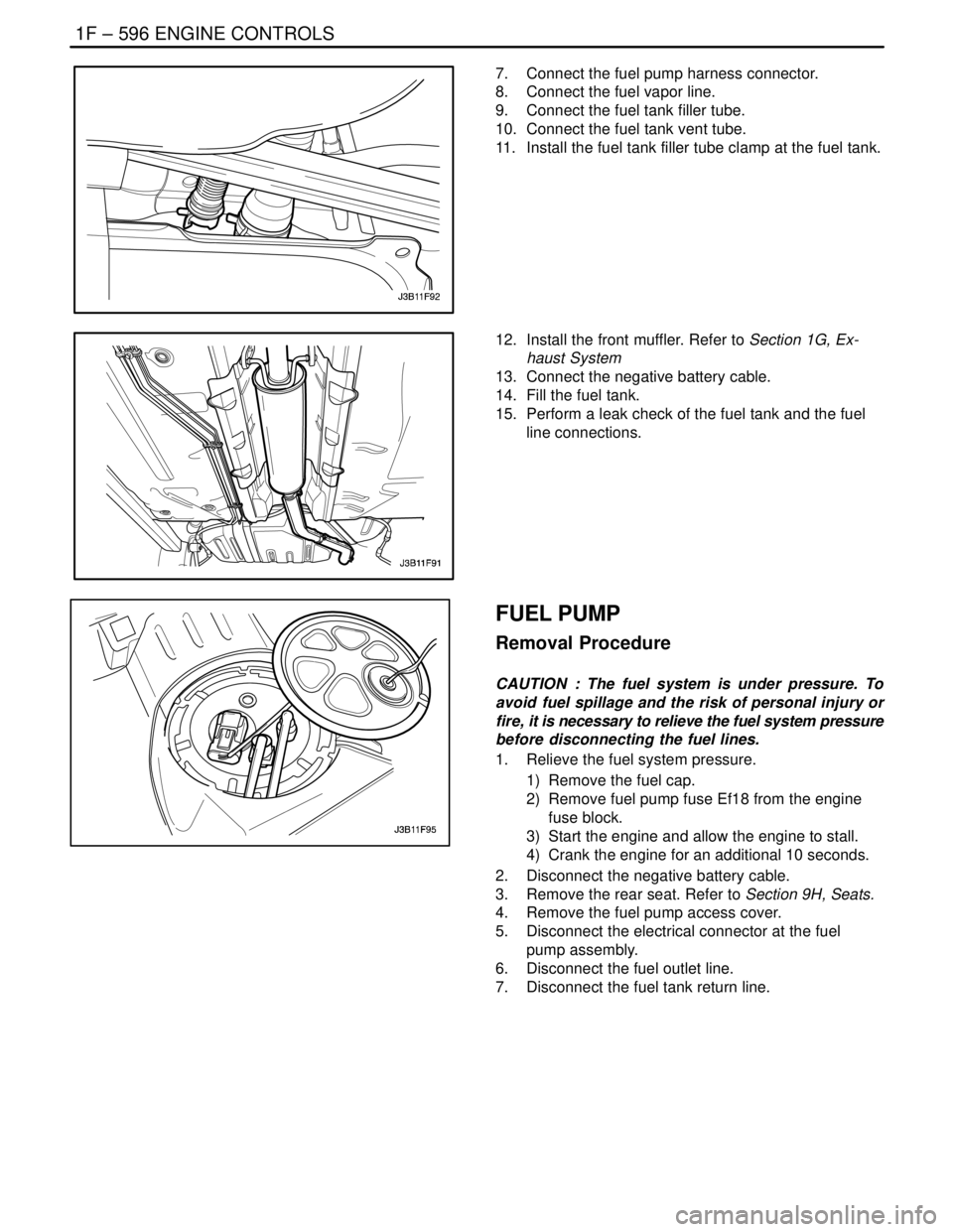Page 837 of 2643

ENGINE CONTROLS 1F – 591
DAEWOO V–121 BL4
EXCESSIVE EXHAUST EMISSIONS OR ODORS
Definition : A vehicle fails an emission test. The vehicle
has an excessive rotten egg smell.Important : Excessive odors do not necessarily indicate
excessive emissions.
Step
ActionValue(s)YesNo
1Were the Important Preliminary Checks performed?–Go toStep 2Go to
”Important Pre-
liminary
Checks”
21. Run the engine until it reaches operating tem-
perature.
2. Perform an emission test.
Does the vehicle pass the emission test?–System OKGo toStep 3
31. Connect the scan tool to the Data Link Con-
nector (DLC).
2. Road test the vehicle.
3. Monitor the long term fuel trim memory.
Is the long term fuel trim memory within the value
specified?–20–25%Go toStep 6Go toStep 4
4Is the long term fuel trim memory below the value
specified?–20%Go to
”Diagnostic
Aids for DTC
P0172”Go toStep 5
5Is the long term fuel trim memory above the value
specified?25%Go to
”Diagnostic
Aids for DTC
P0171”–
61. Check for a properly installed fuel cap.
2. Check the fuel system pressure.
3. Perform an injector balance test.
Is the problem found?–Go toStep 7Go toStep 8
71. Repair or replace any fuel system components
as needed.
2. Perform an emission test.
Does the vehicle pass the emission test?–System OK–
81. Check the ignition system for proper operation.
2. Inspect the spark plugs for excessive wear,
insulation cracks, improper gap, or heavy de-
posits.
3. Check the ignition wires for cracking, hardness,
or improper connections.
Is the problem found?–Go toStep 9Go toStep 10
Page 838 of 2643

1F – 592IENGINE CONTROLS
DAEWOO V–121 BL4
StepNo Yes Value(s) Action
91. Repair or replace any ignition system compo-
nents as needed.
2. Perform an emission test.
Does the vehicle pass the emission test?–System OK–
101. Inspect for vacuum leaks.
2. Inspect the catalytic converter for contamina-
tion.
3. Inspect for carbon buildup on the throttle body
and the throttle plate and inside the engine.
Remove with a top engine cleaner.
4. Check the Exhaust Gas Recirculation (EGR)
valve to make sure it opens.
5. Check for proper Positive Crankcase Ventila-
tion (PCV) operation.
Are all checks and needed repairs complete?–System OK–
DIESELING, RUN–ON
Definition : An engine continues to run after the ignition switch is turned OFF.
Step
ActionValue(s)YesNo
1Were the Important Preliminary Checks performed?–Go toStep 2Go to
”Important Pre-
liminary
Checks”
2Does the engine run smoothly after the ignition
switch is turned OFF?–Go toStep 3Go toStep 4
31. Check the ignition switch and the ignition
switch adjustment.
2. Replace the ignition switch if needed.
Is the repair complete?–System OK–
41. Check the evaporative emission system.
2. Check for leaking fuel injectors.
3. Check the Idle Air Control (IAC) valve opera-
tion.
4. Inspect for vacuum leaks.
5. Check for the proper base idle setting.
Are all checks and repairs complete?–System OK–
Page 839 of 2643

ENGINE CONTROLS 1F – 593
DAEWOO V–121 BL4
BACKFIRE
Definition : Fuel ignites in the intake manifold, or in the ex-
haust system, making a loud popping noise.Important : Before diagnosing the symptom, check ser-
vice bulletins for updates.
Step
ActionValue(s)YesNo
1Were the Important Preliminary Checks performed?–Go toStep 2Go to
”Important Pre-
liminary
Checks”
21. Inspect for crossed or crossfiring ignition wires.
2. Check the ignition system output voltage for all
cylinders using a spark tester.
3. Inspect the spark plugs for excessive wear,
burned electrodes, improper gap, or heavy de-
posits..
Is the problem found?–Go toStep 3Go toStep 4
3Repair or replace any ignition system components
as needed.
Is the repair complete?–System OK–
41. Check the fuel system operation.
2. Check the fuel injectors by performing an injec-
tor diagnosis.
Is the problem found?–Go toStep 5Go toStep 6
5Repair or replace any fuel system components as
needed.
Is the repair complete?–System OK–
61. Inspect the Exhaust Gas Recirculation (EGR)
gasket for a leak or a loose fit.
2. Check the EGR valve for proper operation.
3. Inspect the intake manifold and the exhaust
manifold for a casting flash.
Is the problem found?–Go toStep 7Go toStep 8
7Repair or replace any components as needed.
Is the repair complete?–System OK–
81. Inspect the timing belt for proper installation
and tension.
2. Check the engine compression.
3. Inspect the intake manifold gasket and the ex-
haust manifold gasket for leaks.
4. Check for sticking or leaking valves.
5. Repair or replace any components as needed.
Are all checks and corrections complete?–System OK–
Page 840 of 2643

1F – 594IENGINE CONTROLS
DAEWOO V–121 BL4
MAINTENANCE AND REPAIR
ON–VEHICLE SERVICE
FUEL SYSTEM PRESSURE RELIEF
Procedure
CAUTION : The fuel system is under pressure. To
avoid fuel spillage and the risk of personal injury or
fire, it is necessary to relieve the fuel system pressure
before disconnecting the fuel lines.
1. Remove the fuel cap.
2. Remove the fuel pump fuse Ef18 from the engine
fuse block.
3. Start the engine and allow the engine to stall.
4. Crank the engine for an additional 10 seconds.
FUEL TANK
Removal Procedure
CAUTION : The fuel system is under pressure. To
avoid fuel spillage and the risk of personal injury or
fire, it is necessary to relieve the fuel system pressure
before disconnecting the fuel lines.
1. Relieve the fuel pressure. Refer to ” Fuel System
Pressure Relief ” in this section.
2. Disconnect the negative battery cable.
3. Drain the fuel tank.
4. Remove the front muffler. Refer to Section 1G, Ex-
haust System
5. Remove the fuel tank filler tube clamp at the fuel
tank.
6. Disconnect the fuel tank filler tube.
7. Disconnect the fuel vapor line near the fuel tank
filler tube.
8. Disconnect the fuel pump harness connector.
Page 841 of 2643
ENGINE CONTROLS 1F – 595
DAEWOO V–121 BL4
9. Disconnect the fuel inlet line and the fuel return line
near the right front of the fuel tank.
10. Remove the Fuel pump. Refer to ”Fuel Pump” in
this section.
11. Remove the parking brake cables support brackets.
12. Support the fuel tank.
13. Remove the fuel tank strap retaining nuts.
14. Remove the fuel tank strap.
15. Carefully lower the fuel tank.
16. Remove the fuel tank.
17. Transfer any parts as needed.
Installation Procedure
1. Raise the fuel tank into position.
2. Install the fuel tank straps.
3. Install the fuel tank strap retaining nuts.
Tighten
Tighten the fuel tank strap retaining nuts to 20 NSm
(15 lb–ft).
4. Install the parking brake cables support bracket.
5. Install the fuel pump. Refer to ”Fuel Pump” in this
section.
6. Connect the fuel outlet line and the fuel return line.
Page 842 of 2643

1F – 596IENGINE CONTROLS
DAEWOO V–121 BL4
7. Connect the fuel pump harness connector.
8. Connect the fuel vapor line.
9. Connect the fuel tank filler tube.
10. Connect the fuel tank vent tube.
11. Install the fuel tank filler tube clamp at the fuel tank.
12. Install the front muffler. Refer to Section 1G, Ex-
haust System
13. Connect the negative battery cable.
14. Fill the fuel tank.
15. Perform a leak check of the fuel tank and the fuel
line connections.
FUEL PUMP
Removal Procedure
CAUTION : The fuel system is under pressure. To
avoid fuel spillage and the risk of personal injury or
fire, it is necessary to relieve the fuel system pressure
before disconnecting the fuel lines.
1. Relieve the fuel system pressure.
1) Remove the fuel cap.
2) Remove fuel pump fuse Ef18 from the engine
fuse block.
3) Start the engine and allow the engine to stall.
4) Crank the engine for an additional 10 seconds.
2. Disconnect the negative battery cable.
3. Remove the rear seat. Refer to Section 9H, Seats.
4. Remove the fuel pump access cover.
5. Disconnect the electrical connector at the fuel
pump assembly.
6. Disconnect the fuel outlet line.
7. Disconnect the fuel tank return line.
Page 843 of 2643

ENGINE CONTROLS 1F – 597
DAEWOO V–121 BL4
8. Turn the lock ring counterclockwise to clear the
tank tabs.
9. Remove the fuel pump assembly from the tank.
Installation Procedure
1. Clean the gasket mating surface on the fuel tank.
2. Position the new gasket in place.
3. Install the fuel pump into the fuel tank in the same
location as removed for ease of line and connector
installation.
4. Position the lock ring in place and turn it clockwise
until it contacts the tank stop.
5. Connect the fuel pump assembly connector.
6. Install the fuel pump outlet line.
7. Install the fuel tank return line.
8. Install the fuel pump access cover.
9. Connect the negative battery cable.
10. Perform an operational check of the fuel pump.
11. Install the rear seat. Refer to Section 9H, Seats.
FUEL FILTER
Removal Procedure
CAUTION : The fuel system is under pressure. To
avoid fuel spillage and the risk of personal injury or
fire, it is necessary to relieve the fuel system pressure
before disconnecting the fuel lines.
1. Relieve the fuel system pressure. Refer to ” Fuel
System Pressure Relief ” in this section.
2. Disconnect the negative battery cable.
3. Remove the fuel filter mounting bracket assembly
bolt.
4. Remove the fuel filter cover.
5. Disconnect the inlet/outlet fuel lines by moving the
line connector lock forward and pulling the hose off
of the fuel filter tube.
Page 844 of 2643

1F – 598IENGINE CONTROLS
DAEWOO V–121 BL4
Installation Procedure
1. Install the new fuel filter into the retaining clamp.
Note the flow direction.
2. Install the fuel filter.
3. Connect the inlet/outlet lines. Secure the lines with
the connector lock.
4. Install the fuel filter cover.
5. Install the fuel filter mounting bracket assembly bolt
with the fuel filter ground.
Tighten
Tighten the fuel filter mounting bracket assembly
bolts to 4 NSm (35 lb–ft).
6. Connect the negative battery cable.
7. Perform a leak test of the fuel filter.
FUEL RAIL AND INJECTORS
(1.4L/1.6L DOHC)
Removal Procedure
CAUTION : The fuel system is under pressure. To
avoid fuel spillage and the risk of personal injury or
fire, it is necessary to relieve the fuel system pressure
before disconnecting the fuel lines.
1. Relieve the fuel system pressure. Refer to ”Fuel
Pump”in this section.
2. Disconnect the negative battery cable.
3. Remove the intake manifold bracket bolts.
4. Remove the intake manifold bracket.
5. Disconnect the fuel injector harness connectors.
6. Remove the fuel feed line.
7. Remove the fuel rail mounting bolts.
Notice : Before removal, the fuel rail assembly may be
cleaned with a spray–type cleaner, following package in-
structions. Do not immerse the fuel rails in liquid cleaning
solvent. Use care in removing the fuel rail assembly to pre-
vent damage to the electrical connectors and the injector
spray tips. Prevent dirt and other contaminants from enter-
ing open lines and passages. Fittings should be capped
and holes plugged during service.
Important : If an injector becomes separated from the rail
and remains in the cylinder head, replace the injector O–
ring seals and the retaining clip.